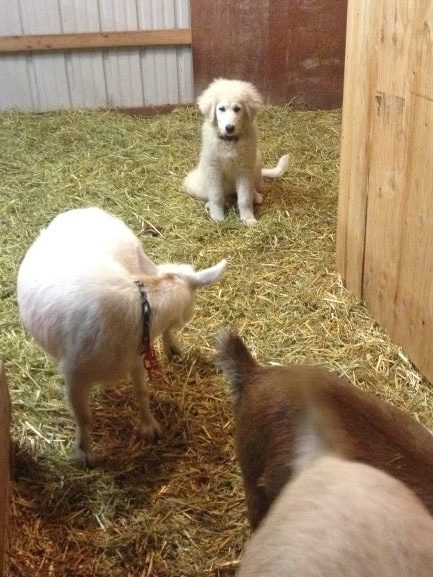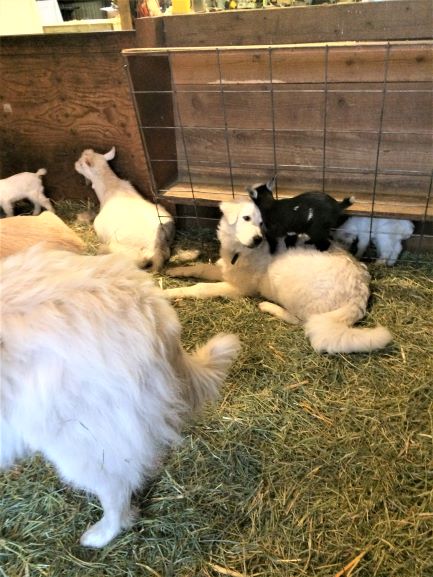
We decided to get a livestock guard dog about five years ago when we came home to an enormous eagle sitting on top of our chicken coop. The hens were safe inside, but screaming their heads off. We had three mama goats in the barn, all expecting and had seen some coyotes. Farms can be violent places. It was just a matter of time.
Allow me to present the “Devine Miss G” (Gwendolyn) seated among the buttercups in this spring photo. Gwen (for short) is our four year-old Great Pyrenees – Maremma Sheepdog cross who has succeeded in scaling any fence my husband, Mark, builds. At this writing, we are on fence version 5.0. Gwendolyn-the-wander-dog (bless her) faithfully lets us know each time she is out and before she takes off running into the wild blue yonder. She usually comes to the back door and barks, having yet again dug under, jumped over, or otherwise cleared a hot-wired fence (maximum setting does not phase her). In her eyes at least, she always has a good reason, things like duck hunters in the neighbor’s field, Canada geese, a car she doesn’t like the look of, or a coyote we can’t see, yet. The last time Miss G appeared at the back door was New Years Eve. It was the fireworks. Her barking let us know this was not manageable. My husband brought her in the house, and she laid in the doorways until 2:00 a.m. so no one would leave. There are no words adequate to describe how much we love this occasionally exasperating canine. I wouldn’t trade her for her weight in gold. My husband might (smile).

We found G through a classified ad in a local ag paper, the Capital Press, and we added her younger partner, “Sadie”, a Maremma Sheepdog, last year. Sadie is the white dog on the left. Our thinking was that companionship might keep Gwendolyn-the-wander-dog in the goat pen, away from a busy road and neighboring farms. The outcome has been a division of duties, worked out between the two of them (a common occurrence between dogs working in pairs). We were never consulted about these arrangements.
Sadie, a tender, somewhat possessive soul, is showing herself to be all about the goats. She is all lovey dovey until you try to take a goat out of the pen. Sadie needs lots of reassurance that everything is going to be fine and “Oyster, Hailey, Piper, Aurora, Button and/or Willapa are coming right back and you can watch through the fence, okay?…whine, whine, whine.” Sadie sticks close to her goats, the barn, and assumes the majority duty for guarding during the day. Gwendolyn, reigning queen of the realm, focuses on the perimeter, especially at night, and frequently catches up on her sleep in the barn during the day. Sadie who now outweighs Gwen is cuddled up to Edith the pug (LGD wannabe) in the picture. Gwendolyn as usual has her eye on the distant universe. I can assure you that Sadie and Gwen see you and have already formed their own opinions.
Approaching the fence tends to get the girls all riled up. On the other hand, heading to the barn for a greeting (with a trusted escort) is a good sign that you know how things are supposed to work around here. Expect Sadie and Gwen to get to the barn before you do and hang over the gate while they eat a couple of plain Milk Bone Dog Biscuits (“cookies”) and get a really good look at you. Miss G has a short list of approved humans (another Great Pyrenees trait). You know who you are. It might take several visits before you get a chance to touch Gwendolyn if you ever do. In the meantime, she’ll step back and shine those other worldly eyes at you. Sadie is friendlier and will give you nuzzle or two and a smile and if she really likes you a pat on the arm with her paw (common Maremma traits). Just don’t mess with her goats.

If I had a crystal ball when I started this LGD stuff, I would have dialed up the Maremma Sheepdog Club of America and found my way to Cindy Benson at Benson Ranch Maremmas in Gold Hill, Oregon on the day we brought G home and kept her on speed dial. Yeah, there are other places you can go to find and learn about livestock guard dogs and Maremmas in particular, but there is nothing like husbandry expert devoted to the science of it all to get a determined novice on the right track. Cindy nicely affirmed that we had done a lot of things right in mentoring Gwendolyn to her role. I will say Cindy ‘s methods for preparing LGD pups made Sadie’s transition to our farm at 11 weeks of age almost seamless. Gwendolyn, Mark and I learned this thing by trial and error. Sadie had a pro.
If you are a novice (like me), the differences between Great Pyrenees and Maremmas are subtle, not dramatic. You can look them up online if you are curious. As puppies, though there is one important thing they have in common. They are among the most adorable creatures on the planet, think baby polar bears. You want to cuddle up with them on the sofa and binge watch Disney in your pajamas!!! Stop. I am not kidding. If you want a livestock guard dog, put your boots and jacket on and take that baby straight back to the barn. This is not a house pet. Do the dog, yourself, and the world a favor and don’t screw this up!




The best guardians are born to working parents and have enough early exposure to bond to livestock. When you bring that pup home, they really need to continue the tradition. The dog needs to live in your barn with your animals and learn trust you as the human owner(s). This part we got right. We ignored stupid stuff we read about only spending 10 minutes a day with Gwen. Some people think too much human contact interferes with a guardian’s bond to the animals they are supposed to protect. There is probably an element of truth here, but there is also a balance. There may be settings where this makes sense, but not on our farm. Even though Gwen was living outside, we made sure she felt like part of the family. She was 11 weeks old and the only dog in the barn! Gwen spent her first nights in a kidding pen full of straw with my husband and I coming regularly in and out to sit, visit, snuggle and groom her. Gwendolyn still loves to be brushed and loves it when we talk to her. She could SEE the goats, but they couldn’t touch her at first. This was important for her safety. She could have been head butted and seriously hurt. We spent LOTS of time in the barn with G and the goats, getting them used to each other. We kept Gwen on a leash and walked the perimeter of her territory together, multiple times a day. The goats followed. We gradually gave G her freedom to walk independently among them.
We taught Gwen to lie down and quietly accept having baby goats jump on her, but it took a couple years of observing her and verbally correcting any sign of rough behavior to be sure she was consistently appropriate, We never hit, jerk or force our dogs and are very careful to misjudge or over correct behavior. Livestock guardians can be very sensitive if in their view they are unfairly corrected. No exaggeration, Gwen will literally pout, deliberately avoid you and not eat for days if she thinks how you treated her was not deserved. Likewise “Gwendolyn, Gwendolyn, Gwendolyn the Wonder Dog” expects to be noticed for a job well done.

Here is Sadie at 16 weeks. Look at those claws. It is so important! Don’t let your LGD play rough. They can maim or kill the animal you need them to protect. They can hurt you and you can create a dog that no one can manage and no one wants. These dogs need all the encouragement you can muster to be “gentle, gentle, gentle.”

Look also for any opportunity to praise guardian behavior. “What do you see over there? Oh good girl for checking that out!” Let me tell you there were days when G was between 12-18 months old I thought I would lose my mind hollering out the back door in my nightgown, NO CHASING!!! Leave Oyster alone!!!. I know our goats have put up with some crap from these dogs, and they have nailed both a time or two. Sadie is a year old and so far so doing pretty good as she enters the too familiar LGD teenage period. She has a different spirit than Gwen. I am not expecting the same degree of challenge. If you can get through this…it’s worth it!

LGDs mature around two years of age. This was certainly so with Gwendoldyn and that was also about the time her bark kicked in (Pyrenees definitely bark more than Maremmas). Dog barking is one of those things that can drive you (and your neighbors) up a wall. Truth! LGDs don’t belong in suburbia. It can be awful hard to listen to a dog telling you about something for an hour straight or longer. Hard to believe sometimes, but these dogs really don’t bark for no reason. The best news is their barking keeps predators away from your livestock and nobody gets hurt. It does take some getting used to, but now we mostly sleep through it or get the hell out of bed to see what the fuss is about. Once somebody flew off the road and drove a truck through our fence and into the goat pasture. Another time it was a pack of coyotes.
Feel the love from the guardians of our galaxy
